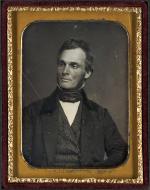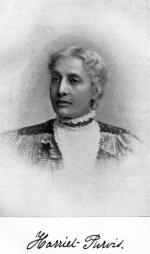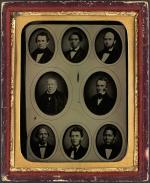![header=[Marker Text] body=[An abolitionist, Purvis fought for the rights of Blacks through his lecturing, writing, and activity in antislavery societies. As an agent for the Underground Railroad, he built a secret area here at his house to hide slaves. ] sign](http://explorepahistory.com/kora/files/1/10/1-A-107-139-ExplorePAHistory-a0a4h4-a_450.gif)
Mouse over for marker text
Name:
Robert Purvis
Region:
Philadelphia and its Countryside/Lehigh Valley
County:
Philadelphia
Marker Location:
1601 Mt. Vernon Street, Philadelphia
Dedication Date:
February 21, 1992
Behind the Marker
In October 1838, the voters of Pennsylvania approved a new state constitution that limited the power of the governor, prohibited the legislature from granting special favors to corporations, and ended life tenure for judges. The new constitution also stripped black Pennsylvanians of their right to vote, a right guaranteed under law since 1790. African Americans had since then lost the ability to vote in some Pennsylvania counties, including Philadelphia. But the constitutional disenfranchisement of black voters was yet another ominous sign of the rising power of the slaveocracy in the United States and of the growing fears of black political and economic power in the state of Pennsylvania.
The appeal quoted above was penned by Robert Purvis, then fast emerging as one of Philadelphia’s most prominent abolitionists. The year before, Purvis was the principal organizer of the Vigilant Association of the Philadelphia, founded to promote the anti-slavery movement and ”to create a fund to aid colored persons in distress.” In the decades that followed he and his wife Harriet would use their home to harbor slaves escaping to Canada along the Underground Railroad and Purvis would act as a tireless leader in the struggle not just for the rights of African Americans, but for the equal rights of all Americans, regardless of their race, nationality, or sex.
Robert Purvis was born in Charleston, South Carolina in 1810 to William Purvis, a wealthy cotton merchant, and Harriet Judah, a woman of Jewish and African ancestry. As a child, Robert was close to his grandmother, Dido Badaracka. Born West Africa, captured and sold into slavery as a child, and then freed upon the death of her owner in 1775, Dido inspired Purvis to take pride in his African heritage. Unable because of Harriet’s mixed race to marry under South Carolina law the Purvises in 1819 fled South Carolina for Philadelphia. Before they could make their next move to England, however, William died, leaving his wife and children a significant inheritance. Harriet remained in Philadelphia with her three sons, who attended Pennsylvania Abolition Society’s Clarkson School, and there became part of a vibrant African-American community. After additional schooling at Amherst Academy in Massachusetts, Robert returned to Philadelphia and in 1832 married Harriet Forten, the daughter of James Forten, one of black Philadelphia’s most successful businessmen and civic leaders.
James Forten, one of black Philadelphia’s most successful businessmen and civic leaders.
Investing his inheritance into real estate, Purvis was able to support his family of eight children and focus his attention on the fight against slavery. His wealth, education, light skin color and white features enabled him to move easily across the color line and to become a leader in the growing abolition movement in Philadelphia. In 1832, at the age of the twenty-two, he wrote a petition with William Whipper opposing Congressional funding of the emigration of free slaves to Africa. In 1833 Purvis helped found the American Anti-Slavery Society and Harriet joined in the founding of
William Whipper opposing Congressional funding of the emigration of free slaves to Africa. In 1833 Purvis helped found the American Anti-Slavery Society and Harriet joined in the founding of  Philadelphia Female Anti-Slavery Society. In 1834, he traveled through England speaking for the abolitionist cause and there embraced the Irish movement for self-government, noting the parallels in African Americans fight for suffrage in the United States. Back in Philadelphia, Purvis joined white abolitionists in founding the Vigilant Committee of Philadelphia, which operated the first and most successful Underground Railroad operation in southeastern Pennsylvania.
Philadelphia Female Anti-Slavery Society. In 1834, he traveled through England speaking for the abolitionist cause and there embraced the Irish movement for self-government, noting the parallels in African Americans fight for suffrage in the United States. Back in Philadelphia, Purvis joined white abolitionists in founding the Vigilant Committee of Philadelphia, which operated the first and most successful Underground Railroad operation in southeastern Pennsylvania.
The public fraternizing of white and black men and women in the abolition movement outraged its opponents. The Purvises were attendees at the second Anti-Slavery Convention of American Women, when a Philadelphia mob burned down Pennsylvania Hall on May 16, 1838. The threat of violence, however, did not deter them. Later in 1838 Purvis joined
Pennsylvania Hall on May 16, 1838. The threat of violence, however, did not deter them. Later in 1838 Purvis joined  James and Lucretia Mott in the founding of the Pennsylvania Anti-Slavery Society.
James and Lucretia Mott in the founding of the Pennsylvania Anti-Slavery Society.
The Purvis’s political activism made them targets of violence on several occasions. On August 1, 1842, when black Philadelphians marched in celebration of Emancipation Day in the West Indies, angry white mobs responded with two days of rioting. Worried for the safety of their family, the Purvises in 1844 moved to a country home in Byberry, then just north of the city, and there harbored fugitive slaves on their farm.
Purvis served as president of the Pennsylvania Anti-Slavery Society from 1845 to 1850 and vice president of the American Anti-Slavery Society from 1841 to 1865. After the Pennsylvania Abolition Society reorganized its Vigilance Committee in 1852 Purvis served as its president until 1857.
Participating in the abolition movement Purvis worked with a committed interracial community of social activists and reformers, including the Motts, William Still,
William Still,  Thomas Garrett, and
Thomas Garrett, and  Stephen Smith. Work in the anti-slavery movement drew him into causes, including women’s suffrage, temperance, and the rights of Native Americans. “In the matter of rights,” he would often state, “there is just one race, and that is the human race.”
Stephen Smith. Work in the anti-slavery movement drew him into causes, including women’s suffrage, temperance, and the rights of Native Americans. “In the matter of rights,” he would often state, “there is just one race, and that is the human race.”
During the Civil War Purvis joined Frederick Douglas and other abolitionist leaders who urged Lincoln to allow black men to join the army. He and Harriet also joined Octavius Catto and the Pennsylvania State Equal Rights League in the campaign to desegregate Philadelphia’s streetcars, which was accomplished by passage of a state law in 1867.
Octavius Catto and the Pennsylvania State Equal Rights League in the campaign to desegregate Philadelphia’s streetcars, which was accomplished by passage of a state law in 1867.
In 1874 the Purvises moved to Washington D.C. where Robert served as a commissioner of the failing Freedman’s Saving Bank. There, after forty-three years of marriage, Harriet died in 1875. Three years later Purvis married Tracey Townsend, a white Quaker poet from Byberry. After moving back to Philadelphia, Purvis remained active in the struggle for human rights and in local politics. He was a leader in the Committee of a Hundred, which helped elect reform Democrat Sam King as mayor of Philadelphia in 1880, worked with the pacifist Universal Peace Union to fight the forced relocation of Native Americans, and participated in the national anti-lynching movement. Remembered by many as “The Father of the Underground Railroad,” Robert Purvis died on April 15, 1898 in Philadelphia.
“We are PENNSYLVANIANS, and we hope to see the day when Pennsylvania will have reason to be proud of us, as we believe she has now none to be ashamed. Will you starve our patriotism? Will you cast our hearts out of the treasury of the commonwealth? Do you count our enmity better than our friendship?”
-Robert Purvis,  Appeal of Forty Thousand Citizens, Threatened with Disfranchisement, to the People of Pennsylvania, 1838.
Appeal of Forty Thousand Citizens, Threatened with Disfranchisement, to the People of Pennsylvania, 1838.
In October 1838, the voters of Pennsylvania approved a new state constitution that limited the power of the governor, prohibited the legislature from granting special favors to corporations, and ended life tenure for judges. The new constitution also stripped black Pennsylvanians of their right to vote, a right guaranteed under law since 1790. African Americans had since then lost the ability to vote in some Pennsylvania counties, including Philadelphia. But the constitutional disenfranchisement of black voters was yet another ominous sign of the rising power of the slaveocracy in the United States and of the growing fears of black political and economic power in the state of Pennsylvania.
The appeal quoted above was penned by Robert Purvis, then fast emerging as one of Philadelphia’s most prominent abolitionists. The year before, Purvis was the principal organizer of the Vigilant Association of the Philadelphia, founded to promote the anti-slavery movement and ”to create a fund to aid colored persons in distress.” In the decades that followed he and his wife Harriet would use their home to harbor slaves escaping to Canada along the Underground Railroad and Purvis would act as a tireless leader in the struggle not just for the rights of African Americans, but for the equal rights of all Americans, regardless of their race, nationality, or sex.
Robert Purvis was born in Charleston, South Carolina in 1810 to William Purvis, a wealthy cotton merchant, and Harriet Judah, a woman of Jewish and African ancestry. As a child, Robert was close to his grandmother, Dido Badaracka. Born West Africa, captured and sold into slavery as a child, and then freed upon the death of her owner in 1775, Dido inspired Purvis to take pride in his African heritage. Unable because of Harriet’s mixed race to marry under South Carolina law the Purvises in 1819 fled South Carolina for Philadelphia. Before they could make their next move to England, however, William died, leaving his wife and children a significant inheritance. Harriet remained in Philadelphia with her three sons, who attended Pennsylvania Abolition Society’s Clarkson School, and there became part of a vibrant African-American community. After additional schooling at Amherst Academy in Massachusetts, Robert returned to Philadelphia and in 1832 married Harriet Forten, the daughter of
Investing his inheritance into real estate, Purvis was able to support his family of eight children and focus his attention on the fight against slavery. His wealth, education, light skin color and white features enabled him to move easily across the color line and to become a leader in the growing abolition movement in Philadelphia. In 1832, at the age of the twenty-two, he wrote a petition with
The public fraternizing of white and black men and women in the abolition movement outraged its opponents. The Purvises were attendees at the second Anti-Slavery Convention of American Women, when a Philadelphia mob burned down
The Purvis’s political activism made them targets of violence on several occasions. On August 1, 1842, when black Philadelphians marched in celebration of Emancipation Day in the West Indies, angry white mobs responded with two days of rioting. Worried for the safety of their family, the Purvises in 1844 moved to a country home in Byberry, then just north of the city, and there harbored fugitive slaves on their farm.
Purvis served as president of the Pennsylvania Anti-Slavery Society from 1845 to 1850 and vice president of the American Anti-Slavery Society from 1841 to 1865. After the Pennsylvania Abolition Society reorganized its Vigilance Committee in 1852 Purvis served as its president until 1857.
Participating in the abolition movement Purvis worked with a committed interracial community of social activists and reformers, including the Motts,
During the Civil War Purvis joined Frederick Douglas and other abolitionist leaders who urged Lincoln to allow black men to join the army. He and Harriet also joined
In 1874 the Purvises moved to Washington D.C. where Robert served as a commissioner of the failing Freedman’s Saving Bank. There, after forty-three years of marriage, Harriet died in 1875. Three years later Purvis married Tracey Townsend, a white Quaker poet from Byberry. After moving back to Philadelphia, Purvis remained active in the struggle for human rights and in local politics. He was a leader in the Committee of a Hundred, which helped elect reform Democrat Sam King as mayor of Philadelphia in 1880, worked with the pacifist Universal Peace Union to fight the forced relocation of Native Americans, and participated in the national anti-lynching movement. Remembered by many as “The Father of the Underground Railroad,” Robert Purvis died on April 15, 1898 in Philadelphia.







![A Group of Philadelphia Abolitionists with Lucretia Mott [seated second from the right]. A Group of Philadelphia Abolitionists with Lucretia Mott [seated second from the right].](http://cache.matrix.msu.edu/expa/small/1-2-1BA3-25-ExplorePAHistory-a0n0v8-a_349.jpg)
